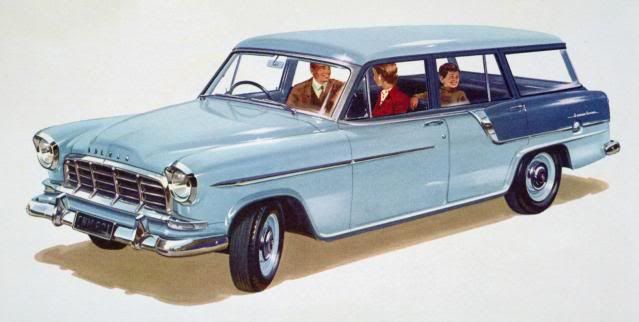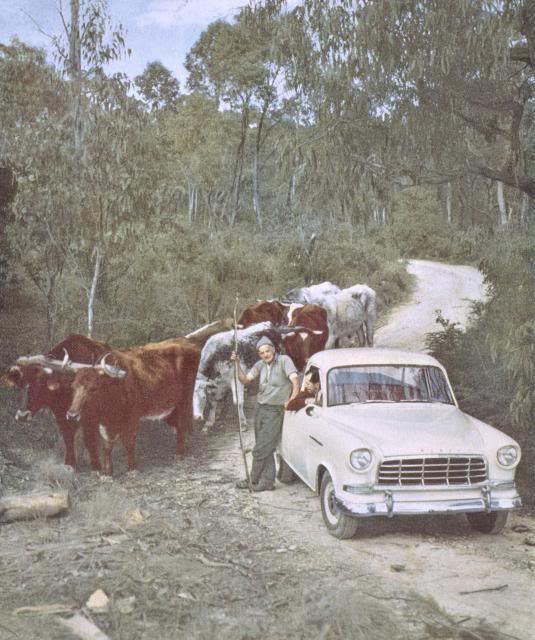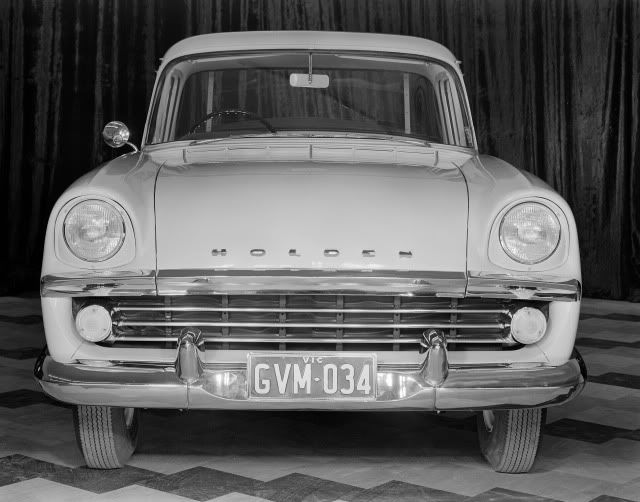The protracted dream of a mass-produced Australian automobile has become reality on October 1, 1948, when the very first Holden 48-215 left the assembly line. This car has enjoyed a tremendous response from the Australian public. Its success is still very much alive, and now reaches beyond Australia’s borders: Holden cars are exported to New Zealand, South-East Asia, Africa and, starting this year, to the American state of Hawaii in a new left-hand drive version, while Ute pickups are assembled in South Africa and Indonesia as CKDs.
Holden Standard
In May 1958, the Holden FE has been superseded by a revised FC, which features a new grille, modified dashboard and steering wheel, and minor mechanical improvements. Nevertheless, the Holden FC remains the rugged vehicle that the Australians have been brought to love.

● Introduction: July 1956 as the FE, May 1958 as the FC. Construction: monocoque. Engine: water-cooled inline six, 2.2-litre, 72 hp, mounted at the front. Transmission: to the rear wheels through a three-speed manual gearbox. Suspension: independent at the front, rigid axle at the rear. Brakes: hydraulic, to drums on all four wheels. Length: 449 cm. Top speed: 140 kph. Range: four-door sedan, four-door station sedan.
Holden Business
The Business is a simplified version of the FC, that is mostly aimed at taxicab operators. It is exclusively available as a sedan.
● Introduction: July 1956 as the FE, May 1958 as the FC. Construction: monocoque. Engine: water-cooled inline six, 2.2-litre, 72 hp, mounted at the front. Transmission: to the rear wheels through a three-speed manual gearbox. Suspension: independent at the front, rigid axle at the rear. Brakes: hydraulic, to drums on all four wheels. Length: 449 cm. Top speed: 140 kph. Range: four-door sedan.
Holden Special
The Special is a fancier version of the FC, designed for those Australian drivers who find the Holden too austere. It enjoys many minor improvements and sports an elegant two-tone paint.

● Introduction: July 1956 as the FE, May 1958 as the FC. Construction: monocoque. Engine: water-cooled inline six, 2.2-litre, 72 hp, mounted at the front. Transmission: to the rear wheels through a three-speed manual gearbox. Suspension: independent at the front, rigid axle at the rear. Brakes: hydraulic, to drums on all four wheels. Length: 449 cm. Top speed: 140 kph. Range: four-door sedan, four-door station sedan.
Holden Commercial
The FC Commercial series gathers the “Utility” or “Ute”, a pickup that has already proved very popular in rural areas, and a panel van variant.

● Introduction: February 1957 as the FE, May 1958 as the FC. Construction: monocoque. Engine: water-cooled inline six, 2.2-litre, 72 hp, mounted at the front. Transmission: to the rear wheels through a three-speed manual gearbox. Suspension: independent at the front, rigid axle at the rear. Brakes: hydraulic, to drums on all four wheels. Length: 449 cm. Top speed: 140 kph. Range: two-door Utility pickup, two-door panel van.
Holden FB
In January 1960, the Holden gets even more Americanized with the introduction of the Series FB, a heavier, longer, flashier evolution of the FC. Long fins are now incorporated to the rear part of the car, as well as ever more chrome. The new windshield is of “wraparound” type, and a new dashboard matches this fancy style. Alas, despite receiving a stronger suspension, more efficient brakes and a slightly enlarged engine, the Holden’s performances suffer from this sudden increase in weight. The range remains virtually the same as the FC’s, except for the deletion of the Business variant.

● Same as FC, except: Introduction: July 1956 as the FE, January 1960 as the FB. Engine: inline six, 2.3-litre, 75 hp. Length: 461 cm. Top speed: 130 kph.
Any mistake you’ve just spotted? A detail to add? A suggestion? Don’t hesitate to leave a comment!
Click to jump to another model year of the same car: 1957 – 1958 – 1959 – 1960 – 1961 – 1962
Click here to return to a list of all Holden vehicles presented on this blog.
Click here to return to this blog’s initial post, featuring a list of all vehicles already presented.
Holden Standard
In May 1958, the Holden FE has been superseded by a revised FC, which features a new grille, modified dashboard and steering wheel, and minor mechanical improvements. Nevertheless, the Holden FC remains the rugged vehicle that the Australians have been brought to love.

● Introduction: July 1956 as the FE, May 1958 as the FC. Construction: monocoque. Engine: water-cooled inline six, 2.2-litre, 72 hp, mounted at the front. Transmission: to the rear wheels through a three-speed manual gearbox. Suspension: independent at the front, rigid axle at the rear. Brakes: hydraulic, to drums on all four wheels. Length: 449 cm. Top speed: 140 kph. Range: four-door sedan, four-door station sedan.
Holden Business
The Business is a simplified version of the FC, that is mostly aimed at taxicab operators. It is exclusively available as a sedan.
● Introduction: July 1956 as the FE, May 1958 as the FC. Construction: monocoque. Engine: water-cooled inline six, 2.2-litre, 72 hp, mounted at the front. Transmission: to the rear wheels through a three-speed manual gearbox. Suspension: independent at the front, rigid axle at the rear. Brakes: hydraulic, to drums on all four wheels. Length: 449 cm. Top speed: 140 kph. Range: four-door sedan.
Holden Special
The Special is a fancier version of the FC, designed for those Australian drivers who find the Holden too austere. It enjoys many minor improvements and sports an elegant two-tone paint.

● Introduction: July 1956 as the FE, May 1958 as the FC. Construction: monocoque. Engine: water-cooled inline six, 2.2-litre, 72 hp, mounted at the front. Transmission: to the rear wheels through a three-speed manual gearbox. Suspension: independent at the front, rigid axle at the rear. Brakes: hydraulic, to drums on all four wheels. Length: 449 cm. Top speed: 140 kph. Range: four-door sedan, four-door station sedan.
Holden Commercial
The FC Commercial series gathers the “Utility” or “Ute”, a pickup that has already proved very popular in rural areas, and a panel van variant.

● Introduction: February 1957 as the FE, May 1958 as the FC. Construction: monocoque. Engine: water-cooled inline six, 2.2-litre, 72 hp, mounted at the front. Transmission: to the rear wheels through a three-speed manual gearbox. Suspension: independent at the front, rigid axle at the rear. Brakes: hydraulic, to drums on all four wheels. Length: 449 cm. Top speed: 140 kph. Range: two-door Utility pickup, two-door panel van.
Holden FB
In January 1960, the Holden gets even more Americanized with the introduction of the Series FB, a heavier, longer, flashier evolution of the FC. Long fins are now incorporated to the rear part of the car, as well as ever more chrome. The new windshield is of “wraparound” type, and a new dashboard matches this fancy style. Alas, despite receiving a stronger suspension, more efficient brakes and a slightly enlarged engine, the Holden’s performances suffer from this sudden increase in weight. The range remains virtually the same as the FC’s, except for the deletion of the Business variant.

● Same as FC, except: Introduction: July 1956 as the FE, January 1960 as the FB. Engine: inline six, 2.3-litre, 75 hp. Length: 461 cm. Top speed: 130 kph.
Any mistake you’ve just spotted? A detail to add? A suggestion? Don’t hesitate to leave a comment!
Click to jump to another model year of the same car: 1957 – 1958 – 1959 – 1960 – 1961 – 1962
Click here to return to a list of all Holden vehicles presented on this blog.
Click here to return to this blog’s initial post, featuring a list of all vehicles already presented.
No comments:
Post a Comment